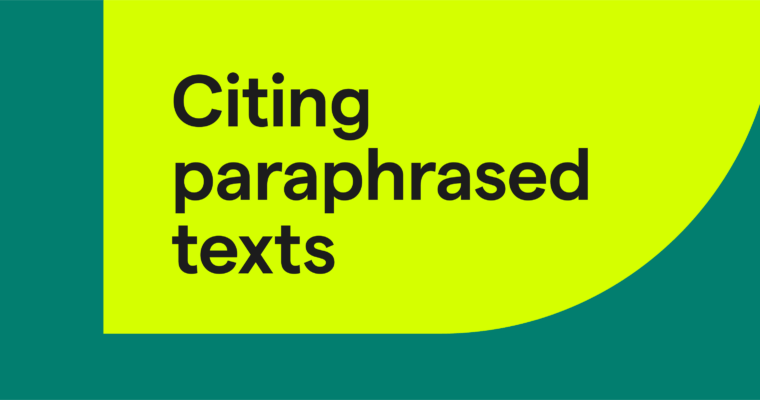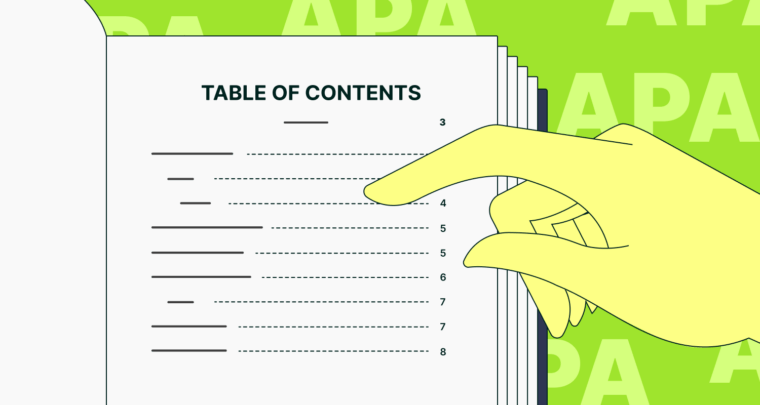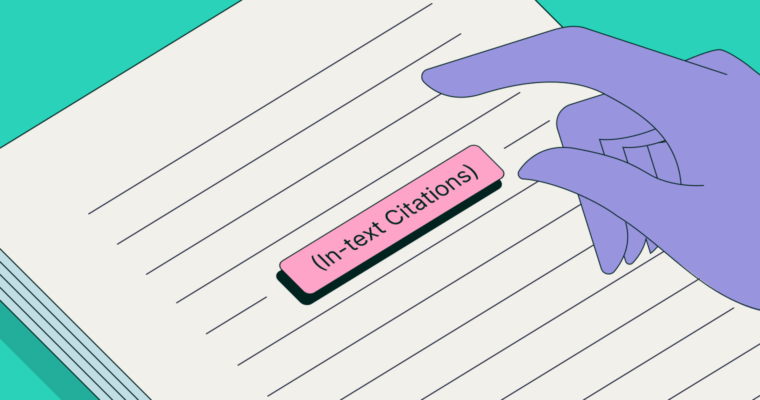
You may think citing sources for research papers is confusing . . . because it absolutely is! It’s one thing to memorize the precise format for your sources’ information, but it’s another thing to know the precise formats required by APA, MLA, and Chicago style guides.
Because different styles have different citation formats, we thought showing you some citation examples in research papers would help you learn to tell the difference. Feel free to use this guide as a resource to help you get the perfect citation, no matter what style you use.
Jump to:
How to use citation examples in research
- APA in-text citation examples
- APA citation examples: Book
- APA citation examples: Journal Article
- APA citation examples: Website
- APA citation examples: Video
- APA citation examples: AI
- MLA in-text citation examples
- MLA citation examples: Book
- MLA citation examples: Journal Article
- MLA citation examples: Website
- MLA citation examples: Video
- MLA citation examples: AI
- Chicago in-text citation examples
- Chicago citation examples: Book
- Chicago citation examples: Journal Article
- Chicago citation examples: Website
- Chicago citation examples: Video
- Chicago citation examples: AI
Citation examples for multiple authors
- APA citation examples for more than one author
- MLA citation examples for more than one author
- Chicago citation examples for more than one author
How to use citation examples in research
In academic writing like research papers, you must cite your source for each piece of information that’s not your own. In informal writing like personal essays, you are your own source, so you don’t need a citation. But for writing that uses information from outside books, articles, websites, videos, or even AI, citations are necessary.
The tricky part is that each style has its own particular way of citing sources. Most academic papers are written in one of the three main styles:
Each of these styles has different rules for what information to include in citations, as well as unique guidelines for particulars like capitalization, the use of italics, and the order in which the information comes. (For more details, read our direct comparison of MLA vs. APA.)
In this blog post, we share citation examples of each style for different types of sources. But first, let’s talk a little about the different types of citations you’ll be using in formal writing.
In-text citations vs. full citations
The two main types of citations are in-text citations and full citations.
In-text citations appear in the body text of the paper and provide the bare minimum of information to identify the source. These usually include the author’s name and sometimes a page number or publication date. They can be either parenthetical or narrative, which we explain below. Alternatively, if you’re using Chicago style, you have the option to use footnotes as in-text citations.
Full citations appear in the bibliography at the end of the text and contain all the relevant information from a source. The idea is that, if your reader is interested in learning more about one of your sources, they can find it in the full citation. Full citations are written in a particular way, and different styles have their own rules for what information goes where.
In APA, the bibliography is called a reference page; in MLA, it’s called a works cited page. Only Chicago uses the term “bibliography.”
Parenthetical citations vs. narrative citations
In-text citations can be either parenthetical citations or narrative citations. A parenthetical citation puts a brief credit in parentheses after the related piece of information. Here’s an in-text citation example in APA:
Not all experiments use a placebo group because “if your patients are ill, you shouldn’t be leaving them untreated simply because of your own mawkish interest in the placebo effect” (Goldacre, 2008, p. 60).
A narrative citation, on the other hand, gives credit in the body text itself, such as by mentioning the author by name. Typically, any information not included in the text is still placed in an abbreviated parenthetical citation afterward.
Not all experiments use a placebo group because, as Ben Goldacre wrote, “if your patients are ill, you shouldn’t be leaving them untreated simply because of your own mawkish interest in the placebo effect” (2008, p. 60).
Our in-text citation examples below are for standard parenthetical citations. Just remember if you mention the author, page, or year in the main text, you can remove it from the parenthetical citation.
APA citation examples
APA in-text citation examples
In-text citations in APA use what’s called the author-date style, which includes the author’s last name and the year of publication, separated with commas.
If citing a specific piece of information or a direct quote, also include the location, such as a page number or timestamp. Use the abbreviations p. for page, pp. for pages, and paras. for paragraphs. For general information, such as a concept discussed throughout the source, no location is needed.
(Last Name, Year, p. #)
(Goldacre, 2008, p. 60)
APA citation examples: Book
To cite a book in APA, you need the author’s name, year of publication, book title, and publisher. The author’s name is written as “last name, first name initial,” as in “Shakespeare, W.” Titles use sentence-style capitalization, which means only the first letter of the first word in the title (and subtitle, if applicable) are capitalized. If the book edition is relevant, place it in parentheses after the title.
Last name, First name initial. (Year of publication). Title. Publisher.
Goldacre, B. (2008). Bad science. Fourth Estate.
APA citation examples: Journal article
Citing an article in APA requires the author’s last name and first initial; the full date of publication, including month and day if applicable; and the titles of both the article and the journal/periodical, as well as the page number. Note that, unlike MLA and Chicago styles, APA doesn’t abbreviate months in citations.
Last name, First name initial. (Year, Month Day of publication). Article title. Magazine name, volume(issue), page range. DOI
Cardanay, A. (2016, January 12). Illustrating motion, music, and story. General Music Today, 29(3), 25–29. doi:10.1177/1048371315626498
APA citation examples: Website
To cite a website in APA, follow the same format you use to cite journal articles, except without volume, issue, or page numbers. Website citations in APA include a URL, however. If the website represents a print publication, italicize the title. If not, italicize the article name.
Last name, First name initial. (Year, Month Day of publication). Title of article, post, or page. Website. URL
Hudson, J. (2023, November 12). What Taylor Swift can teach us about leadership. Forbes. https://www.forbes.com/sites/jameshudson/2023/11/12/what-taylor-swift-can-teach-us-about-leadership/
APA citation examples: Video
To cite YouTube in APA, as well as any online video, you need to include both the uploader’s real name and username, the date posted, the video title, the website name, and the URL. You also need to include the word “Video” in brackets after the video title to show what kind of source it is.
Real last name, First initial. [Username]. (Year, Month Day). Video title [Video]. Website. URL.
Desmond, W. [TED-Ed]. (2019, December 19). The philosophy of cynicism [Video]. YouTube. https://www.youtube.com/watch?v=Utzym1I_BiY
APA citation examples: AI
According to the APA website, AI citations in APA should be treated as an “algorithm’s output.” You cite the company that built it as the author, the name of the AI as the title, and the year you interacted with it as the date of publication. You should also include the version you used and a descriptor like “large language model” in brackets, followed by the URL.
Company. (Year). AI Name (version) [Descriptor]. URL
OpenAI. (2023). ChatGPT (March 14 version) [Large language model]. https://chat.openai.com/chat
MLA citation examples
MLA in-text citation examples
For MLA, in-text citations use only the author’s last name and the page number or timestamp, without abbreviations or commas.
(Last name #)
(Goldacre 60)
MLA citation examples: Book
To cite a book in MLA, you need the author’s name, book title, place of publication, publisher’s name, and the date of publication. The author’s name is inverted, with the last name coming before the first name. Most parts are separated by periods, except for the author’s names and publication information, which are separated by commas. Titles use title capitalization, which capitalizes the first letter of each major word.
Last name, First name. Book Title. Place of publication, Publisher, publication date.
Goldacre, Ben. Bad Science. London, Fourth Estate, 2008.
MLA citation examples: Journal article
Citing an article in MLA is similar to citing a journal article in other styles, although MLA uses abbreviations for volume (vol.) and issue number (no.), as well as pages (pp.). If you found the article online, you also need to include the database name in italics and the URL or DOI.
Last name, First name. “Title of article.” Journal, vol. #, no. #, Day Month Year of publication, pp. #–#. Database, DOI or URL.
Cardanay, Audrey. “Illustrating Motion, Music, and Story.” General Music Today, vol. 29, no. 3, 2016, pp. 25–29. Academic Search Premier, doi:10.1177/1048371315626498.
MLA citation examples: Website
To cite a website in MLA, include the page or article title in quotes and the name of the website in italics. In addition to the publication date and URL, you also need to mention the date you visited the website, using the word “Accessed.”
Last name, First name. “Page or Article Title.” Website, Day Month Year of publication, URL. Accessed Day Month Year.
Hudson, James. “What Taylor Swift Can Teach Us about Leadership.” Forbes, 12 Nov. 2023, https://www.forbes.com/sites/jameshudson/2023/11/12/what-taylor-swift-can-teach-us-about-leadership/. Accessed 13 Nov. 2023.
MLA citation examples: Video
Citing YouTube in MLA is similar to citing videos in APA, although the information goes in different places. Additionally, you need either the creator’s real name or username, but not both.
Username or Last name, First name. “Title.” Website, Day Month Year, URL.
Desmond, William. “The Philosophy of Cynicism.” YouTube, 19 Dec. 2019, https://www.youtube.com/watch?v=Utzym1I_BiY.
MLA citation examples: AI
AI citations in MLA ignore the author altogether and use the AI prompt (what you typed into the chat) as the title. MLA uses “containers” for sources within larger works, and for AI the container is the name of the AI. You also need the version, company (as the publisher), date accessed, and URL.
“Entered text” prompt. AI Name, version, Company, Day Month Year, URL.
“Citation examples for research” prompt. ChatGPT, GPT-4, OpenAI, 15 Nov. 2023, chat.openai.com/chat.
Chicago citation examples
Chicago in-text citation examples
In Chicago, you can choose either parenthetical citations or footnotes for in-text citations. Chicago’s parenthetical citations also use an author-date style just like APA citations; however, there is no comma between the author and year (although there is a comma between the year and the location). Chicago citations do not use abbreviations for page numbers.
(Last Name Year, #)
(Goldacre 2008, 60)
Chicago citation examples: Book
Citing a book in Chicago uses the author’s name, book title, place of publication, publisher, and year of publication. You also include the edition, but only if it’s relevant. The author’s name is inverted, and the title uses title capitalization.
Last Name, First Name. Book Title: Subtitle. Edition (if applicable). Place of Publication: Publisher, Year.
Goldacre, Ben. Bad Science. London: Fourth Estate, 2008.
Chicago citation examples: Journal article
Citing an article in Chicago is most similar to citing an article in MLA, including the type of information to include and the use of abbreviations. Pay attention to the citation examples to see the correct order and punctuation to use; note that in Chicago the volume number directly follows the journal title and is not separated by a comma or preceded by the word “vol.”
Last name, First name. “Article title.” Journal vol. #, no. # (Year): #–#. Database or article URL.
Cardanay, Audrey. “Illustrating Motion, Music, and Story.” General Music Today 29, no. 3 (2016): 25–29. Academic Search Premier.
Chicago citation examples: Website
Compared to citing a website in other styles, citing a website in Chicago is more straightforward. Include all the relevant information, put the article or page title in quotations, and don’t worry about italics or the date you visited (unless the website does not have a publication date; in that case, include the date you accessed the site where you would normally put the publication date).
Last name, First name. “Article or Page Title.” Website, Month Day, Year of publication. URL.
Hudson, James. “What Taylor Swift Can Teach Us about Leadership.” Forbes, Nov. 12, 2023. https://www.forbes.com/sites/jameshudson/2023/11/12/what-taylor-swift-can-teach-us-about-leadership/
Chicago citation examples: Video
To cite YouTube in Chicago, you need to include all the standard information, such as the creator’s name, the title of the video, and the website that hosts it, as well as the date and URL. Unlike other formats, Chicago also requires the total video length written in XX:XX format. You also need to mention the source format (“video”) after naming the website.
Uploader. “Title.” Website and format, duration. Month Day, Year of publication. URL.
TED-Ed. “The Philosophy of Cynicism.” YouTube video, 5:25. Dec. 19, 2019. https://www.youtube.com/watch?v=Utzym1I_BiY.
Chicago citation examples: AI
AI citations in Chicago work differently than in other styles; Chicago considers AI conversations as “personal communication” because they’re non-retrievable—meaning other people can’t access the same conversation you had. Consequently, do not include AI chatbots in the bibliography; mention them only as personal communications if necessary.
However, you still need to use in-text citations for AI in Chicago. For parenthetical citations, you can use the name of the AI as the author and when you had the conversation as the publication date.
Citation examples for multiple authors
APA, MLA, and Chicago formats all have different guidelines for citing more than one author. Here are some quick reference tips on how each does it:
APA citation examples for more than one author
Each author in an APA citation is written in the format of Last name, First Initial. Place authors in the same order as the publication lists them, which may not necessarily be alphabetical. Separate each name with a comma and add an ampersand (&) before the last author’s name.
Marieb, E., & Keller, S. (2018). Essentials of human anatomy & physiology (12th ed.). Pearson.
In-text citations in APA for two authors use both authors’ last names, connected with an ampersand. For more than two authors, use only the first author’s last name and the phrase et al.
(Marieb & Keller, 2018)
(Marieb et al., 2018)
MLA citation examples for more than one author
If an MLA citation has two authors, list them both in the full citation but invert only the first name. Separate them with a comma and the word and.
Cohn, Rachel, and David Levithan. Dash & Lily’s Book of Dares. Ember Publishing House, 2011.
In-text citations use both last names with and.
(Cohn and Levitation 55)
For more than two authors, use only the first author’s name and the phrase et al. in both the full and in-text citation.
Heffernan, James, et al. Writing: A College Handbook. New York, W. W. Norton & Company, 2000.
(Heffernan et al. 27)
Chicago citation examples for more than one author
In the bibliography, Chicago citations list the names of up to ten authors, separated by commas and with the word and before the last author. For more than ten authors, list only the first seven and then add et al. Only the first name is inverted.
Gyatso, Tenzin, and Howard Cutler. The Art of Happiness: A Handbook for Living. Norwalk: Easton Press, 1998.
In-text citations list the last names of up to three authors, separated by commas (if there are more than two), and the word and before the final name. For four or more authors, use only the first author’s last name and the phrase et al.
(Gyatso and Cutler 1998)
(Gyatso et al. 1998)
Cite your sources with Grammarly
Do you want to make sure your citations are formatted correctly and that you haven’t mistakenly plagiarized information while writing your paper? Grammarly can help! Get well-formatted APA, MLA, and Chicago-style citations with Grammarly’s free citation generator built by writing experts. You can also check your work against billions of websites with our plagiarism checker so you always know when to cite your sources. Sign up for free to get academic writing support at your fingertips.





